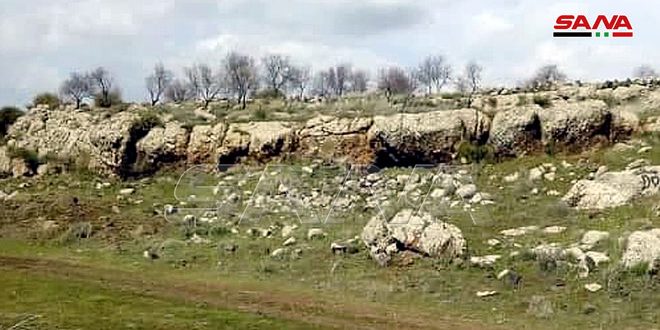Deir Al-Mayyas, Dafiana and Abd Mar an archaeological and cultural repository in the countryside of Sweida
Sweida (ST): The archaeological sites near the town of Al-Ghariya, located in the far southern countryside of Sweida governorate, constitute a cultural extension of the ancient monuments and buildings contained in this town that was inhabited by the ancient man in the middle and modern Stone Age between 2000 and 1200 BC. Traces of ancient man’s drawings and inscriptions can be seen on the walls of the caves located in their hills.
Researcher in the area’s antiquities, Tawfiq al-Safadi, said that the most prominent of those sites are “Al-Dafiana”, whose monuments date back to the second century AD and contain a high palace and walls ending with beautiful and carved crowns, and Deir al-Mayas, which is located to the south of Al-Ghariya, and was mentioned in many archaeological annals of Mount Al-Arab. The ruins of its Nabataean palaces are still visible, and a rectangular pool was restored at the time of Izz al-Din Aybak.
Among the archaeological sites surrounding Al-Ghariya according to Al-Safadi, the hill of “Abd Mar,” which represents a plateau above which there are still traces of a small church. Its foundations indicate the presence of a Roman temple, whose stones bear many inscriptions and arbors of the vine, pointing out that due to the sanctity of the place, in later years, it became a monastery for the ascetics.
Al-Ghariya also surrounds the sites of Nadaiba, Rashida, Shabih, the eastern hill, and Tell Barakat, which is located to the west of the town of Al-Ghariya, which was the home of the ancient man since thousands of years.
Al-Safadi added: The Ghariya is one of three in the Hawran area, indicating that the most important archaeological sites in the town are the remains of the Byzantine Church and the Nabataean temple, many archaeological ruins, statues bearing writing in Greek language, a square-angled altar bearing an inscription in Greek and an archaeological cemetery located to the northeast of it and containing nine tombs that were discovered years ago in addition to a number of archaeological treasures and finds dating back to the Byzantine and Roman.
K.Q.

